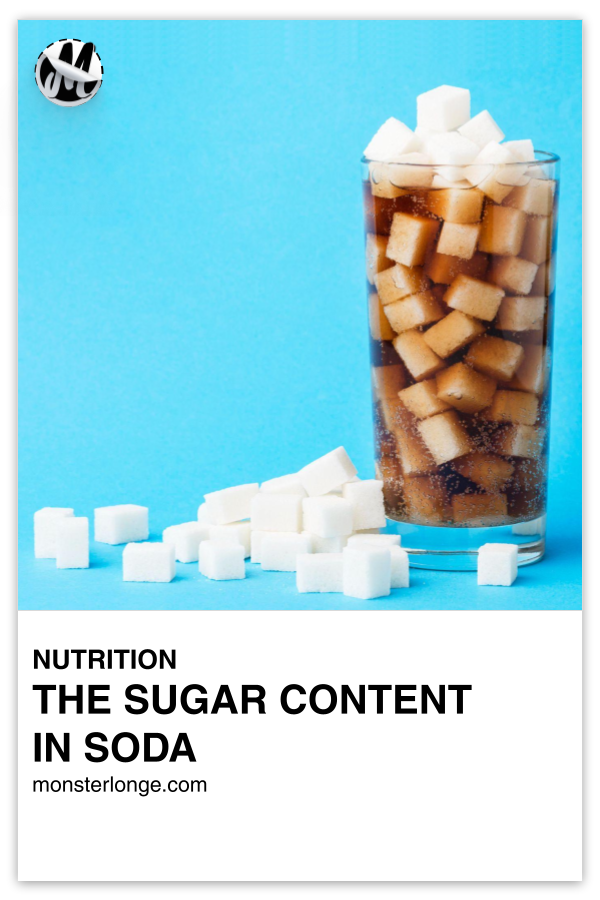
The Sugar Content In Soda
What’s in your soda?
If you said a whole lot of empty calories, then you’re absolutely correct!
Despite all of the calories that are in soda, most, if not all, of the calories come from the sugar content alone. The table below displays the sugar content of many popular soda beverages.
|
|
fl oz. |
Added Sugar (g) |
g/oz |
%DV |
Calories |
|
7-Up Lemon Lime |
12 | 38g | 3.17 | 76% | 140 |
|
A&W Root Beer |
12 | 46g | 3.83 | 92% | 170 |
|
Barq’s Root Beer |
12 | 44g | 3.67 | 89% | 160 |
|
Canada Dry Ginger Ale |
12 | 33g | 2.75 | 66% | 130 |
|
Coca-Cola Original |
12 | 39g | 3.25 | 78% | 140 |
|
Crush Orange |
12 | 43g | 3.58 | 85% | 160 |
|
Dr. Pepper |
12 | 39g | 3.25 | 78% | 150 |
|
Fanta Orange |
12 | 44g | 3.67 | 88% | 160 |
|
Mello Yello |
12 | 46g | 3.83 | 92% | 170 |
|
Mountain Dew |
12 | 46g | 3.83 | 92% | 170 |
|
Mug Cream Soda |
12 | 47g | 3.92 | 95% | 180 |
|
Pepsi Original |
12 | 41g | 3.42 | 83% | 150 |
|
Seagram’s Ginger Ale |
12 | 33g | 2.75 | 67% | 130 |
|
Sprite |
12 | 38g | 3.17 | 76% | 140 |
|
Squirt |
12 | 38g | 3.17 | 76% | 140 |
|
Sun Drop |
12 | 45g | 3.75 | 89% | 170 |
|
Sunkist Orange |
12 | 44g | 3.67 | 87% | 160 |
As illustrated by the table, soda contains a lot of sugar. If you’re in need of immediate energy because, let’s say, your time-management skills suck so you aren’t able to eat a proper preworkout meal at least an hour before walking into the gym, then the shitload of sugar in soda is a good thing. The lack of nutrients in soda other than sugar means that when you pop a can and drink it prior to your workout, your body will absorb the sugar quickly and get it into your bloodstream to provide you with an instant jolt of energy that can be used to power you through it.
Now, where the lack of nutrients in soda is a bad thing is at other times during the day when your body doesn’t need a quick pick-me-up. Drinking soda in those instances is of potentially adverse benefits because when there’s no need for energy and the body is provided with it, that unused energy gets stored as fat by way of the hormone insulin, which spikes with elevated levels of sugar in the bloodstream, which is what soda does.
Further, because sugar doesn’t have a nutritional benefit like fiber, protein, and healthy fats do in helping you feel satiated, you’ll continue to feel hungry after drinking soda. This is problematic because the lack of fullness can lead to seeking out food, which can ultimately result in taking in more calories than your body actually needs. When that happens with enough regularity, that’s when weight gain occurs.
It’s for the above reasons that the prevalence of obesity is greater among soda drinkers than those who don’t drink it as often.
All of this is why you should watch your intake of soda, as well as other sugar-sweetened beverages, particularly if you’re trying to manage your weight. Toward this end, you can eliminate regular soda and swap it for lower or zero calorie drinks like water, tea, and diet soda. Another option is to limit how much soda you consume. One easy way to restrict soda is to avoid the standard 12-ounce and larger can and bottle sizes in favor of smaller cans and bottles that are typically 7.5 or 8 ounces. By unit price, smaller cans and bottles of soda usually sell for significantly more than larger cans and bottles but why you shouldn’t be a cheapo and instead pay a premium for less soda is because a smaller can or bottle serves as an automatic portion controller that allows you to get the taste of a sugary carbonated beverage without gulping down excess calories and as much sugar.
Glossary: calories, dietary fat, fat, gym, hormones, workout
- How To Eat Healthy During Thanksgiving - November 20, 2024
- Weight Loss Tip: no.2620 - November 20, 2024
- Is Going To The Gym Once A Week Enough? - November 19, 2024
